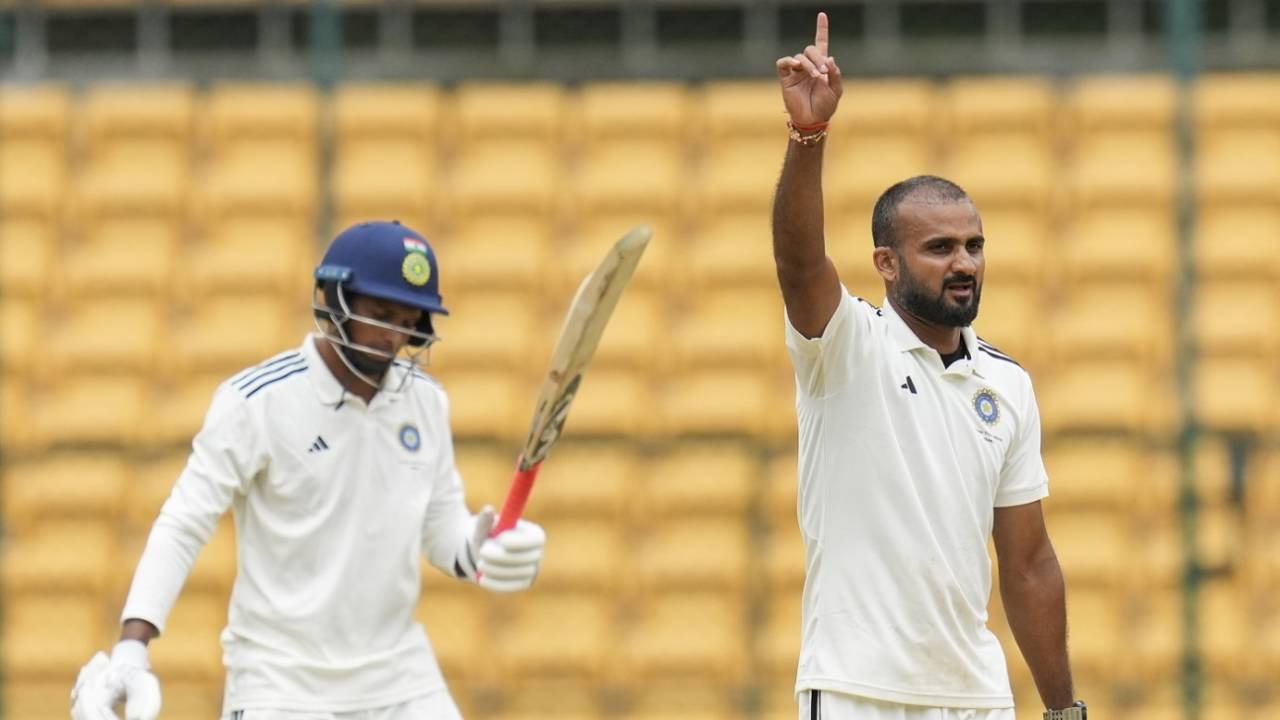The seamer picked up nine wickets in the match to strengthen his case as India’s third seam-bowling option
Akash Deep finished with nine wickets in the match • PTI
Two balls across two innings defined Akash Deep‘s impressive outing in the Duleep Trophy game, where he returned a match haul of 9 for 116 for India A against India B.
The first one was Nitish Kumar Reddy’s wicket, courtesy of late seam movement that squared him up to hit the top of the off stump. The second was a set-up that involved playing with Washington Sundar’s mind.
After troubling him with the ones that straightened from around the wicket, Akash switched back to over the wicket and bent the ball back off the seam from the same spot to beat his inside edge and rattle the stumps.
“The balls I bowled to Nitish Reddy [in the first innings] and Washington Sundar [in the second innings],” Akash said when asked to pick his favourite wicket from the match. “I had been bowling a lot to him [Washington] from around the wicket in the nets. He has been batting a lot against me and had got used to it. So I wanted to do something that I hadn’t done against him before.”
Such planning of his dismissals is something he has learnt from Mohammed Shami. His chats have been around trying to have batters guessing which way the ball will move from the same spot. Shami’s set-up of Ben Stokes at last year’s World Cup is possibly a good example.
“When you bowl to a left-hander from around the wicket, the ball moves naturally towards the shine,” Akash explained. “I spoke to him [Shami] about how to get the ball to come back in [with the angle]. I have seen him do that.
“He advised me not to focus too much on bringing it in. He said it will automatically come over time and when it does, it will become a wicket-taking ball. Because if it keeps going out and then you are able to bring it back in with the shine, it’s tough for batsmen. But he has cautioned me against trying it a lot. But as a bowler, if you’re able to do it, then batters will have a tendency to chase balls away as well.”
This ability to generate lateral movement both ways stood out, as much as Akash’s ability to bowl long spells even when at times it felt as if there wasn’t much happening off the pitch. Akash sent down 41 overs across both innings, comfortably the most among all the bowlers in this match. He put this down to the conditioning work he did at the NCA over the past month.
“My last proper match was my Test debut in March,” he said. “In the IPL, I played just one game. As a fast bowler, it’s difficult to come back [after such a long stretch]. I was at the NCA for a month, I played a lot of practice games keeping in mind the kind of situations we will face in a real match, so that the muscle memory is used to the rigours of a first-class match.”
Akash’s memorable Duleep Trophy outing sets him up nicely to be in the race for the third seamer’s slot for the upcoming home Tests, if Shami continues to remain unavailable. Asked if this performance will help him add to his maiden Test appearance against England, especially with a Test tour to Australia coming up, Akash said he wanted to stay in the present.
“I think of every match as my last match,” he said. “I don’t think too far ahead. What happens [the selection] is not in my hands. I’m here in the present, thinking about my process. I’ve now finished a match, tomorrow is a rest day so how can I recover well? I think more about those things. I’m only thinking in the present.”
Is he satisfied with his performance?
“As a player, the moment you’re satisfied, you won’t learn. As long as that hunger is there to learn, you should not be satisfied. Getting wickets and the final result is different. The ball that I wanted to bowl, how much of it was I able to execute properly? What could I have improved? That’s what I was thinking about all the time.”
Shashank Kishore is a senior sub-editor at ESPNcricinfo



